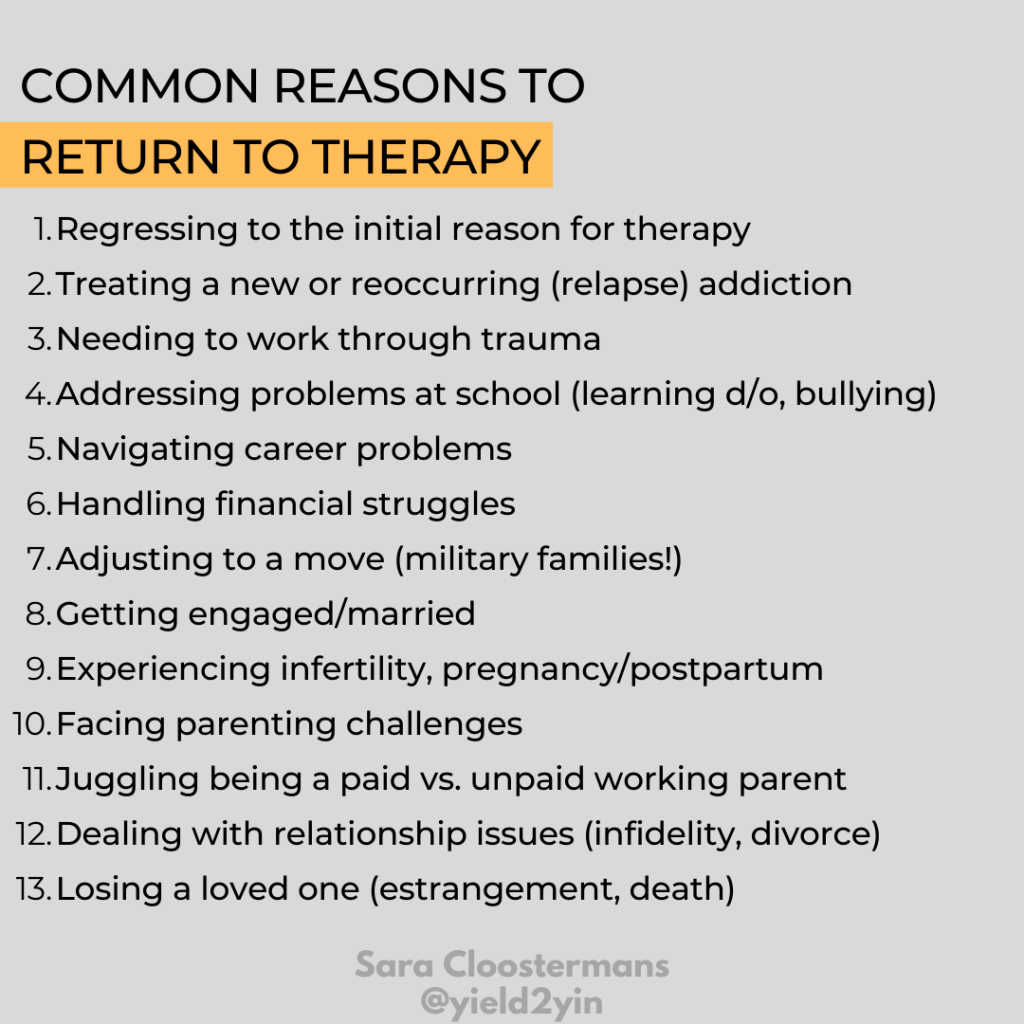If you’ve never been to therapy before, the whole experience may feel like being the new kid at school … or the new hire at a well-established company … You don’t know who everybody is, where to go, how things operate, where you should put your bag, or if they’ll be nice to you at lunch.
This blog serves as the sidekick to show you the ropes. We’re demystifying psychotherapy. What therapy is. Who you can see. The types of sessions to expect. The goals.
Here are two things to realize up front:
First off – the taboo nature of going to therapy greatly decreased amid the pandemic – more people from across all demographics are accepting the idea that, just like we should see physical health specialists when we have physical health concerns, we need to see mental health professionals when we have mental health issues.
Next – therapy is for everyone. Not only for people who are on the brink of divorce or people who have experienced trauma or have other forms of mental health concerns. Every single human being benefits from therapy in the same way everyone benefits from checkups at the doctor or regular exercise or a healthy diet. It’s an act of self-care.
What Is Psychotherapy?
Psychotherapy is a type of therapy that helps people who are facing mental health challenges improve their overall well-being. By far the most common client complaints therapists come across are clients being impacted by symptoms of depression and/or anxiety (at various levels of severity).
Why Go To Therapy?
Here are some of the most common treatment objectives in psychotherapy:
- psycho-education (for example, someone experiencing anxiety learning about the sympathetic nervous system, or fight/flight/freeze/fawn response, and the parasympathetic nervous system, aka the rest and digest response)
- emotional regulation (breathwork meditation, progressive muscle relaxation, validating feelings, compassionate self-care actions, self-soothing talk, etc.)
- stress reduction and improved coping skills (yoga, journaling, exercise, socializing, calming music, dance, art, nature activities, etc.)
- trigger identification – ask yourself: “What started or worsened my symptoms?” (incl. trauma triggers with PTSD)
- behavioral changes (time management, bedtime routine, environmental changes, rewards, etc.)
- cognitive work (awareness of thinking errors, cognitive restructuring, coherent and constructive narrative of one’s life story)
- improved communication skills (active listening, paraphrasing, being mindful of non-verbal communication and tone, assertiveness and boundary skills, etc.)
How Do I Choose My Therapist?
Look for someone who is credentialed to provide psychotherapy (and ask them about their clinical expertise):
- Psychiatrist, M.D. (doctor of medicine who specializes in psychiatry)
- Can they prescribe medications? – yes
- Can they administer and interpret psychological testing? – a psychiatrist will refer you to a psychologist for psychological testing and to a neuropsychologist for neuropsychological testing because they are the ones who are expertly trained in these areas
- Can they teach at college level? – a psychiatrist is more likely to teach students in medical school or psychiatry students doing their psychiatric residency than to teach students in a psychology program; a psychiatrist can also be a guest lecturer on topics such as anatomy or physiology in other health science graduate programs.
- Licensed Psychologist – Ph.D. or Psy.D. (they are NOT medical doctors, but have a doctorate degree in psychology)
- Can they prescribe medications? typically not, but in certain states, they are allowed to prescribe psychotropic medications with additional training (not in California)
- Can they administer and interpret psychological testing? – yes
- Can they teach at college level? – yes, they can teach students who are obtaining a doctorate degree in psychology as well as master’s degree and undergraduate degree students with a psychology major
- Licensed Marriage and Family Therapist – LMFT (master’s degree)
- Licensed Professional (Clinical) Counselors LPCC or LPC – (master’s degree)
- Licensed Clinical Social Workers, LCSW – (master’s degree)
- Can they prescribe medications – no
- Can they administer and interpret psychological testing – no
- Can they teach at college level? – yes, they can teach students who are obtaining a master’s degree in their same field as well as undergraduate degree students with the same major (marriage and family therapy, social work, and counseling respectively)
FYI – a life coach has no formal education in psychology and is not licensed to practice psychotherapy.
Look for some of or all of these 10 traits when screening different therapists during your initial phone call or your first/intake session:

What Are The Different Formats Of Therapy?
There are four different formats of psychotherapy (individual, group, couples, and family) and each format has several different approaches (aka orientations, theories, or schools of thought) to therapy – with each format, I am adding a list of five different approaches to therapy, but the number of approaches listed below is not exhaustive. Keep in mind that the same therapy approach can be used in some or all of the different formats. For example, cognitive-behavioral therapy can be used in individual, group, couples, and family therapy.
- Individual Therapy
- Group Therapy
- Couples Therapy
- Family Therapy
Please note that most therapists use methods, strategies, or techniques from various therapy orientations – this is called an integrative approach to therapy (formerly known as an eclectic approach) – it involves pulling methods from different theories to best serve a particular client in their specific circumstances. I, for one, consider myself to be an integrative therapist and implement strategies from the following schools of thought:
- humanistic
- attachment
- trauma-focused cognitive behavioral therapy (adapted for treatment of adults) – as well as straight
- CBT, of course (I personally don’t know of a therapist who does not know how to use CBT or one who does not use at least some tools derived from CBT)
- holistic
What Are The Three Phases Of Psychotherapy?
There are 3 different phases in therapy (and there are also “subphases,” which I am not covering in this blog):
The First Phase: The Relationship Building Phase
The first phase obviously includes the start of the relationship between the client and the therapist. I feel that Carl Rogers, a humanistic psychologist who developed the client-centered or person-centered approach to therapy, summarized it best when he came up with three attributes all therapists should have in order to be able to create a strong working alliance with their clients:
- empathic understanding
- unconditional positive regard
- genuineness and congruence
This phase of developing a relationship is also known as the “commitment” phase, and includes the assessment of the presenting problem: “What is it that prompted the client to seek therapy in this moment in time?” It also includes the clinical assessment, which is obtained through 1. the therapist’s observations, 2. the psychological self-report measures by the client (e.g. a depression, an anxiety, and a trauma inventory), and 3. the clinical interview. This last piece refers to the communication between the client and the therapist that is geared towards collecting the data necessary to help the therapist make an accurate diagnosis and, in collaboration with the client, develop a treatment plan.
What is a treatment plan?
What is the client hoping to accomplish by going to therapy? What are the client’s goals and objectives? Next, what are the interventions that are going to be implemented to reach these treatment goals? And finally, what therapy approach (or approaches) is the therapist going to use to help the client reach their goals (one of the most well-known evidence-based treatment approaches to treat symptoms of depression and anxiety, for example, is “CBT” – Cognitive Behavioral Therapy)? All these questions should be answered in the treatment plan.
If clients are struggling with coming up with treatment goals, the magic wand question is a great question to ask them in order to learn more about what their most immediate needs for change are: “If you had a magic wand and you could use its magic right now to solve all of your problems that brought you into therapy today, what are some of the differences you would notice about yourself walking out of this session? What differences do you think other people would notice about you?” It is important that all goals and interventions are positively stated, specific, measurable, and that there is a timeline. Otherwise, there is no effective way to monitor the client’s progress.
Here is an example to explain goals and interventions that are positively stated, specific, measurable, and with a timeline:
Say, one of my clients, let’s call her Ella, is depressed. I ask Ella the magic wand question and she answers “I would no longer be depressed.” I now remind her that all goals have to be positively stated, so she answers “I would be happy again” (positively stated). I then ask her to be more specific: “What would you notice would be different about you if you were happier again and what would other people, such as your friends, family, or co-workers notice to be different about you? Now Ella says, “I would smile more, I would exercise regularly, and I would meet up with my friends again (specific)”.
OK, now we are getting somewhere: we have three goals. By the way, three goals is a typical number of goals to start therapy with because more would overwhelm the client. Not only that, once the client improves in these three areas (mood, exercise, socialization), it is a sign that the depressive episode is lifting in general, and therefore extremely likely that we see improvement in other areas of Ella’s life as well, such as improved sleep, healthier appetite, increased work motivation, etc.
But at this point we still do not have our interventions. For the sake of time, I will only focus on one of the three goals to explain the difference between goals and interventions. I will use the “I would meet up with my friends again” goal. On the treatment plan this would probably be entered as “increased socialization,” and on the intake assessment a typical corresponding presenting problem could be “isolation and loneliness.”
Here is Ella’s 3-Month Treatment Plan, which can be reviewed and updated at any time during the 3-month time period – (timeline)
- Improved mood
- Increased exercise
- Increased socialization
- Call one friend/week and talk for a minimum of 20 minutes. If your friend is not picking up, leave a voicemail requesting a call back. If your friend does not call back, call them again, or call a different friend – (measurable)
- Go out with one friend/week, either for a walk or for a coffee/tea, and spend a minimum of one hour together. When you meet up with your friend, schedule your next get-together then and there – (measurable)
- Say hi to one of your neighbors once/week and chat for a minimum of 5 to 10 minutes, either when you see each other on the driveway, or actively take initiative (for example, schedule to drop of a jar of jam) – (measurable)
Note: the therapist follows up on “homework” regularly during session times.
The Second Phase: The Working Phase
In the working phase, the client shows up at regular therapy sessions, as agreed upon in their informed consent form signed before or at the start of the first session, to work on the various goals stipulated in their treatment plan. Attending sessions and engaging in therapy after establishing a relationship with their therapist and developing a treatment plan is similar to showing up to and participating in all your classes after meeting the instructor and receiving a course syllabus the first day of class.
The second phase is the hardest part of therapy. Some people think that, after each therapy session, a client’s mood feels instantly lighter, but that is not necessarily true. Sometimes, depending on what came up during the session, the client feels worse, and that is OK as long as they ultimately start feeling better – think of this scenario as going through “growing pains“.
Unfortunately, there is another scenario, albeit rare, in which a client’s mental health does not improve, not immediately after a session nor later on. If a client is both treatment resistant as well as medication resistant (here referring to traditional psychotropic medications), the therapist, in collaboration with the client’s psychiatrist and the client, looks at other options, such as brain stimulation (Electroconvulsive Therapy, Repetitive Transcranial Magnetic Stimulation, Deep Brain Stimulation, Vagus Nerve Stimulation, Magnetic Seizure Therapy) and novel therapies (Ketamine, Psilocybin, Anti-Inflammatories, Novel Therapeutic Compounds and Rapid Acting Antidepressants).
Generally speaking though, clients walk away from therapy with newly gained insight and helpful coping skills, which they then use in their day-to-day lives. They start looking at the world through a different lens, change up patterns and behaviors, communicate better with the people they choose to or have to engage with, and so on. Of course, the generalization of these skills will only happen if the clients practice them frequently outside of the therapy room; most of the work of therapy takes place outside of the consultation room – this is when the real and lasting changes occur.
The Third Phase: The Closing Phase
The final phase of psychotherapy, which constitutes the end of the therapeutic alliance between the client and their therapist, is called the closing phase or the termination phase. In this phase, the client and therapist have mutually agreed that it is time to wrap up the client’s regular therapy sessions for the time being (not necessarily final) because either the client has accomplished their treatment goals or has reached a plateau.
During the last few sessions, it is typical for the therapist to share their observations about the client’s accomplishments and strengths. The therapist also explores the client’s feelings about their relationship ending (at least for now). An appropriate closure to the client-therapist relationship is imperative because too often clients have experienced past relationships that ended abruptly. These sudden losses of relationships may have left some clients feeling traumatized; thus, a sensitive ending to the client-therapist relationship has the potential to provide these clients with a corrective healing experience.
As the client and therapist talk about the client’s plans for the future, it is also typical for the therapist to remind the client that a “relapse” is not unusual, and sometimes, even to be expected. When I say “relapse,” I’m not necessarily referring to an addiction relapse since I don’t specialize in substance abuse treatment, but I am referring to a mental health relapse instead.
For example, if a client starts out therapy with a diagnosis of major depressive disorder (MDD), recurrent (meaning they have had a MDD diagnosis before), it is likely they will have more depressive episodes in the future. So, you could call a future episode a “relapse” or a “regression” (not to be confused with past life regression therapy) in their mental health.

Therefore, many therapists, including myself, have an open door policy; even with a full client caseload, most therapists try their hardest to squeeze in former clients who are seeking immediate therapy again because of a relapse (or new presenting problems) – we would hate for these clients to have to start up services with a brand new mental health professional if we can avoid it.
Most therapists also offer booster sessions; even when life is good, clients may choose to occasionally check in for follow-up sessions; for instance, to do preventative work, maintenance work, or to simply update their therapist on the client’s current life circumstances, including on their mental health status. Booster sessions can be scheduled from anywhere between once a month to once a year (there are no strict rules); they also ensure that clients remain “established” clients (vs. new clients).
Your health insurance will always favor brief or short-term therapy since this is obviously the most cost-effective route. They will submit the research of empirically validated therapies that not only work short-term, but are more effective short-term than long-term. My recommendation is to look at different research across the board, and not just the findings funded or provided by health insurance companies. And if you have Netflix, I recommend watching the documentary, directed by Jonah Hill, called “Stutz” (Phil Stutz is Jonah Hill’s psychiatrist), and checking out Stutz’ therapy tools that he used in his sessions with his client/patient Johan Hill. Never underestimate the healing power of an honest and a loving long-lasting client-therapist working relationship.
Yield2Yin
- Healing Card Deck: A Therapist’s Advice 55-Card Healing Deck by Sara Cloostermans
- Book Recommendation: Maybe You Should Talk To Someone by Lori Gottlieb
- Mantra: I AM WORTHINESS // with diaphragmatic breathing
- Yin Yoga Asana: Seal Pose







